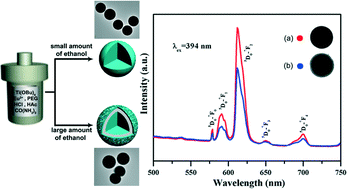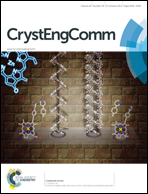Fabrication and photoluminescence properties of TiO2:Eu3+ microspheres with tunable structure from solid to core–shell
Abstract
Monodisperse solid and core–shell structured TiO2:Eu3+ microspheres have been successfully prepared by a facile one-step hydrothermal method using polyethylene glycol (PEG, MW 20 000) as the soft template, titanium tetrabutoxide (TBOT) as the titanium source, and ethanol as the solvent. The XRD patterns show that the direct hydrothermal synthesized products are anatase titanium dioxides. TEM and SEM observations indicate that the amount of ethanol plays an important role in the formation of TiO2:Eu3+ microspheres. Solid TiO2:Eu3+ microspheres are formed by using small amounts of ethanol, while core–shell structured ones are formed by using large amounts of ethanol. Possible growth mechanisms of both the solid and the core–shell structured TiO2:Eu3+ microspheres are also proposed in this paper. In addition, without any further calcination, the direct hydrothermal synthesized solid and core–shell structured TiO2:Eu3+ microspheres show strong red emission corresponding to the 5D0 → 7F2 transition of the Eu3+ ions under ultraviolet excitation. However, the luminescence intensity of the solid microspheres is much higher than that of the core–shell structured TiO2:Eu3+ microspheres, which might be due to the fewer defects and much more effective doping of Eu3+ ions into the solid microspheres.


 Please wait while we load your content...
Please wait while we load your content...